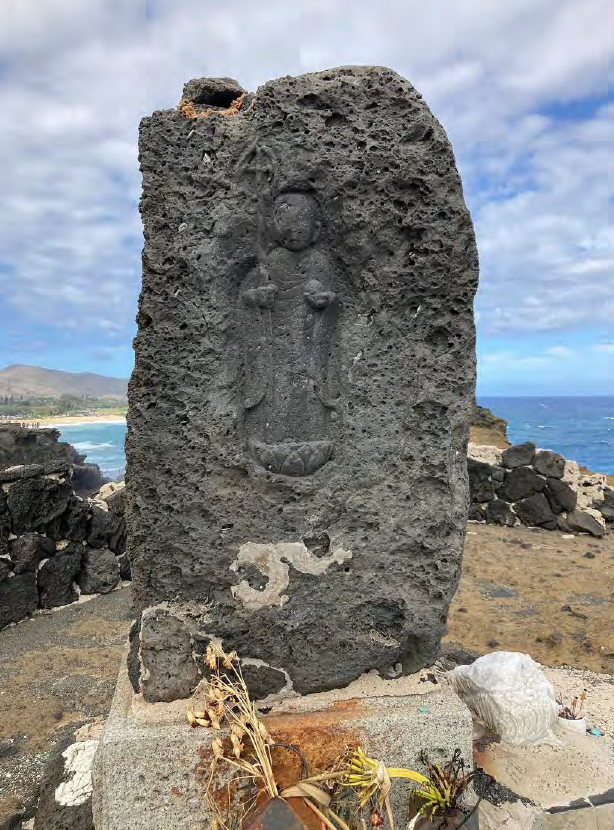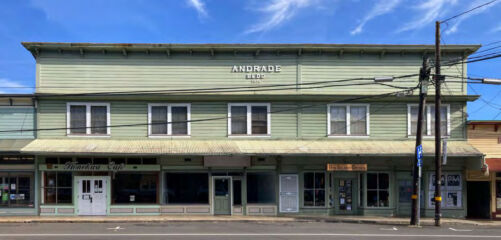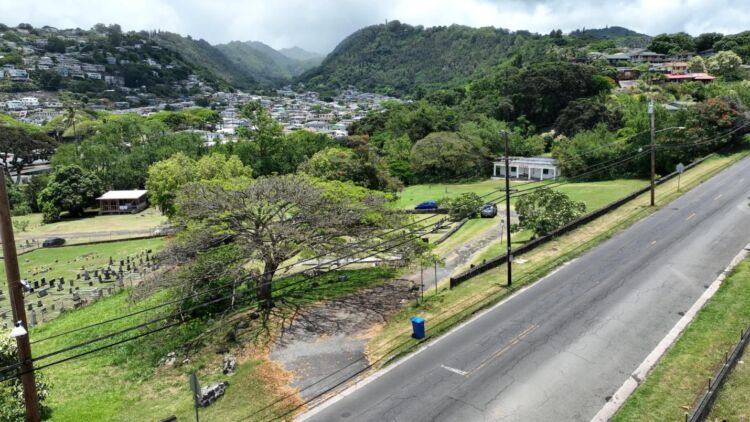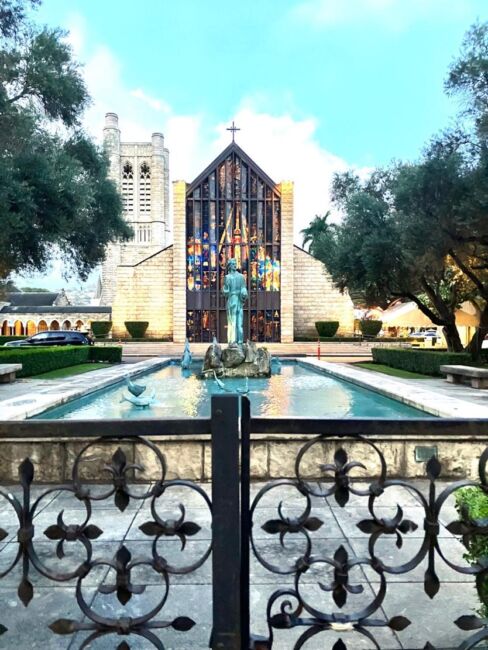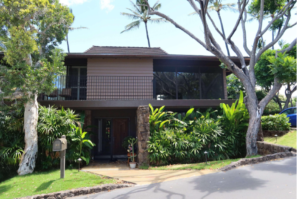The Hawai‘i Historic Places Review Board added ten properties to the Hawai‘i Register of Historic Places in November 2023 and February 2024. Learn more about their history, characteristics and significance.
Properties are eligible for inclusion in the register if they meet one or more criteria of historic significance: A) association with broad patterns or events; B) associations with historic individuals; C) architecture and design; or D) likely to yield important information.
Halona Point/Bamboo Ridge Ojizo Stone Monument, O‘ahu
The Ojizo (guardian) Monument stands at the Bamboo Ridge overlook at Halona Point (Koko Head). It is among the significant Honolulu stone monuments carved by sculptor and engraver Sentaro Otsubo, whose primary business was carving gravestones. This is the third Ojizo at this location; vandals destroyed the first two free standing statues placed there to protect fisherman who frequent this popular and challenging ulua fishing spot. The Monument, carved and installed in 1935, is made of lava rock and uses the engraved carving method in which inscriptions are incised and material removed leaving recesses that allow light and shadows to describe the bas relief and calligraphy. The Ojizo Monument is significant under Criterion C as an excellent example of twentieth century stone carving. It is also significant under Criterion A for its contribution to the theme of the creation of permanent stone monuments around southern O‘ahu to honor Issei and Nisei Japanese American ancestors.
period. View the nomination.
John J. Andrade, Sr. Property, Hawai‘i
The John J. Andrade property is comprised of one and two-story buildings that have been renovated, expanded and altered over time prior to 1973. The complex consists of three sections: a long and rectangular two-story structure; a small, square two-story property, site of the former Andrade Hotel, and the squarish single-story ‘Ōhi‘a Lanai. The property is significant under Criterion C as a good example of wood commercial and residential buildings constructed in the Plantation style between approximately 1920-1930. The property is also significant under Criterion A as an example of a Portuguese American family engaged in small businesses to meet their own needs and contribute to the needs of the larger community. One of the oldest such operations in Honoka‘a, three generations of the Andrade family have lived on the property and operated their businesses there: a meat market, restaurant and laundry, between 1926 and 1973.
View the nomination.
Sakuichi and Chieko Matsumoto Residence, Kaua‘i
Located in a quiet, residential neighborhood in Po‘ipū, the Sakuichi and Chieko Matsumoto residence is a post and pier, single-story, single wall craftsman/bungalow style residence with an attached garage and laundry room. The walls are tongue-and-groove with an exterior girt and lattice apron with a square pattern around the foundation. Other notable features include use of local lava rock on the porch, battered columns, a roof with overhanging eaves with exposed rafter tails, a flowing living-dining room space and use of built-ins such as the hall linen closet and dressing table niche in the front bedroom. Built in 1949, the house is significant under Criterion C as a very good example of the final years of the bungalow style in Hawai‘i and on Kaua‘i. It is one of only two houses on the street to survive Hurricane Iniki in 1992. View the nomination.
Yee King Tong Cemetery, O‘ahu
Yee King Tong became an association in 1889 and offered members a burial plot on the slopes of Punchbowl in return for a membership fee, initiating the creation of the Yee King Tong Cemetery. The cemetery was one of several Chinese cemeteries established in this area in the late nineteenth century and is significant under Criterion A for its associations with the Chinese in Hawai‘i. It is significant, too, under Criterion C as a good example of a Chinese cemetery active in Hawai‘i from the late 19th through the 21st century. The Cemetery represents typical tombstone designs of the period, and the presence of many headstones written in Chinese reflects the ethnic origins of the cemetery as does the existence of a bone house. Preferred funerary practices dictated that after death, people’s remains be held in containers in a bone house until circumstances enabled them to be disinterred and sent back to China for burial in the village of one’s birth. View the nomination.
Homelani House, O‘ahu
The Homelani House is a two and-a-half-story wooden building with shingle finish exterior and plaster finish interior in the Colonial Revival Craftsman/Shingle style. Constructed in 1926, the home is significant under Criterion C as a wood post and pier designed by master architect Albert Ely Ives. Ives also completed a 1946 renovation on the property. Fine craftsmanship ties together many notable features including original Douglas Fir flooring, arched front entry doorway, pocket doors from dining room to outdoor lanai, original kitchen cabinets, coffered ceilings living room and dining room and fireplace with tile inlay surrounding the opening. Homelani House is significant under Criterion A as well as one of the first homes built as part of the Dowsett Tract, an early residential subdivision located in an area just outside of downtown Honolulu. View the nomination.
St. Andrew’s Cathedral, O‘ahu
Listed on the Hawai‘i State and National Registers in 1973, St. Andrew’s Cathedral is significant for its association with the early history of the Anglican religion in Hawai‘i. The Cathedral is said to be one of the finest examples of Gothic Revival architecture in Hawai‘i. Construction was ongoing, with the choir completed in 1886, the nave partially completed and the building consecrated in 1902 with additional construction in 1908 and 1958.
This amendment to the original nomination adds the Fountain of St. Andrew as a contributing feature. The statue was younger than 50 years old in 1973 when the nomination was submitted but has since become eligible . The amendment also adds the landscape architecture of the Fountain court with its olive trees, lighting and plaza with seating as contributing site and object, and expands the period of significance to include the Fountain’s creation. Completed in 1958, the Fountain of St. Andrew includes the sculpture of St. Andrew and the Fish designed by world renowned Croatian sculptor, Ivan Mestrovic. Mestrovic, architect Carleton M. Winslow and well-known sculptor Robert Laurent. Together, the three designed the large-scale Fountain made from sandstone and bronze in the Late Gothic Revival style, to be a place of inspiration, welcome and refreshment within its urban environs. View the nomination.
La Pietra Townhouse, O‘ahu (Multiple Property Nomination)
The La Pietra Townhouse is a multiple property nomination. The townhouse was conceived in 1967 and built in 1971 by architect Louis Pursel and developer Bert Williams. The site was landscaped by San Francisco landscape architecture firm Eckbo, Dean, Austin and Williams. The site is comprised of 19 duplexes and 38 units. In 2022, 14 units were listed in the historic register; another six units were added in August 2023 and two more added in November 2023. The dwelling units are significant at the local level under Criterion A for their associations with the development of townhouse complexes in Hawai‘i and for their associations with historic preservation in Hawai‘i. View the nominations.
The 2 units added to the historic register are:
Condominium Unit 6: James Ariyoshi and H. Robert Hampton Apartment
Condominium Unit 13: Duane and Harriet Wedman Residence
- Unit 6: James Ariyoshi and H. Robert Hampton Apartment
- Unit 13: Duane and Harriet Wedman Residence
The Bower’s House, O‘ahu
The Bower’s House is a two-story residence built in 1931 and one of the first eleven homes in the Maunalani Heights subdivision on Oahu. The home is significant under Criterion A as part of a neighborhood that commemorates the growth of Honolulu’s first automobile suburbs, being the highest elevation development accessible to autos at the time. The home is also significant under Criterion C as an example of Colonial Revival Style architecture and a house designed by Armena Louise Morse Eller (1895–1996), one of Hawaiʻi’s earliest known female architects. The builder was Dean H. Lake. Distinctive features include the three-story lava stone chimney, foundation and many rock walls on the property that divide the slope into terraces. Classic Hawaiian design elements such as the large casement windows in every room and open arch doorways between rooms promote cross-ventilation. The built-in furniture, crown molding and wall panels recall arts & craft construction. View the nomination.
The Dilks Property, O‘ahu
The Dilks Property, constructed in 1974, is located on a beachfront lot in Lanikai, a neighborhood within Kailua on O‘ahu. The property hosts two contributing structures, a one-story, Hawaii Regional style wood-frame main residence (Dilks House) and a small cottage (Hau Cottage) with attached garage. In addition, eight mature hau trees that grow throughout the property are contributing site features. The residence is significant under Criterion C as an excellent example of a Hawaii Regional style residence and the work of a master, architect Vladimir Ossipoff, who designed the home. It is believed the Dilks house is the final residential project that Ossipoff designed and managed from schematic design through construction and incorporates many of his early tropical design tenets. The Hau Cottage, which informed the Ossipoff design for the main residence and site, is a contributing resource as an excellent example of the small weekend beach retreats common in Lanikai when the area was first opened up for development. Design features exemplify an earlier Hawaiian vernacular sense of place incorporating a relaxed, open-air tropical lifestyle with the progression of views and spaces and the indoor/outdoor living provided by two large lanai. View the nomination.


